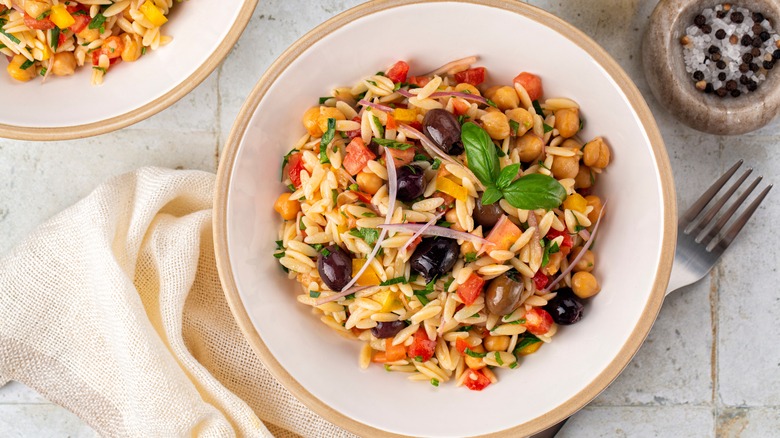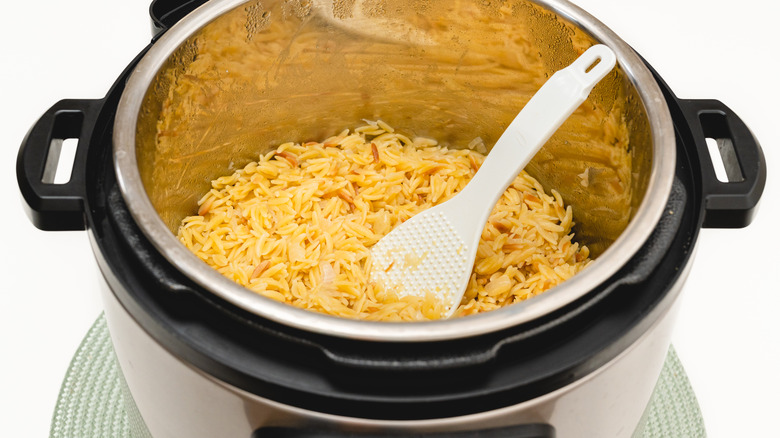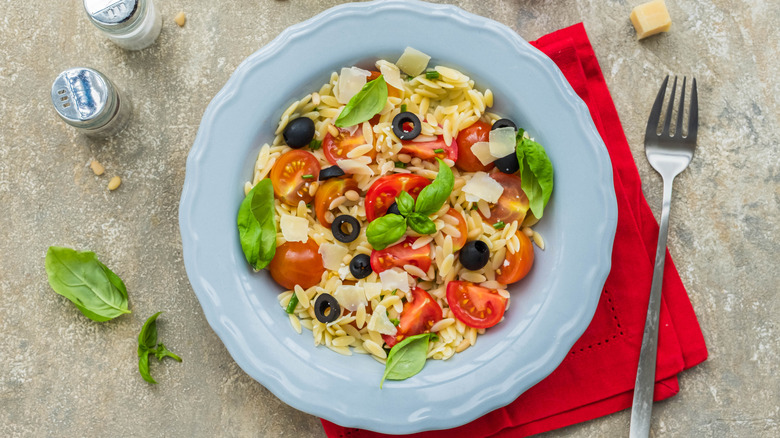How To Cook Orzo In A Rice Cooker
Orzo may look like large grains of rice, and is often called risi (meaning rice) in Italian. In reality, it's a small shape of pasta made from semolina flour, belonging to a category called pastina (little pasta). Its resemblance to rice isn't only in appearance, though, as it can be cooked in similar ways, and that even includes preparing it in a rice cooker.
While orzo is quick to cook in a pan on the stove, taking around 10 minutes, a rice cooker is also a fairly fast method with the bonus of being hands-off. This appliance produces tender, evenly-cooked results in 15 to 20 minutes, and during that time, you can feel free to prepare other ingredients or side dishes to serve with the pasta. Using a rice cooker frees up space on the stove, making it even easier to get on with other tasks instead of babysitting a pot of orzo.
A rice cooker also creates extra-creamy orzo, as the pasta absorbs the starchy water it cooks in — on the stove, you'd pour most of that water out. Simply add two cups of water into the pot for every cup of the pasta, and cook on the regular rice cooking setting. Once the rice cooker has finished the job, let the orzo sit for several minutes before opening the lid. Fluff the pasta up with a fork to separate the pieces and improve the texture, and you'll be ready to dress it.
Try cooking orzo in broth for extra flavor
This basic formula for orzo in the rice cooker is super easy, but it can also be tweaked to produce even better results. While starch in the cooking liquid is great for producing a creamy texture, too much can cause the orzo to clump. You won't be able to stir it frequently, like you can on the stove, so take some extra precautions to get rid of excess starch. Rinse the pasta with cold water before putting it in the rice cooker, which also helps it turn out fluffy.
Adding a little olive oil to the pot can give the pasta a richer taste, as well as preventing it from sticking together. A pinch of salt enhances the flavor even further. To get more creative, try cooking orzo in broth rather than using water. Using chicken, vegetable, or mushroom broth will allow the grains to absorb a ton of extra savory flavor. Cooked this way and tossed with just a few extra seasoning, the orzo becomes a great side dish for meat, fish, or vegetable dishes.
Rice and orzo can sometimes be used interchangeably, but their flavors and textures differ, not to mention many recipes call for different types of rice that don't resemble orzo much at all. However, there are occasions when orzo can work perfectly in a dish normally centered around rice, and can even make your recipe a little easier.
Different ways to serve orzo in place of rice
Orzo is often advertised as a great substitute for the rice in risotto, the classic Italian dish of creamy, short-grain arborio rice cooked with broth and aromatics. There are a few key differences between orzo and risotto, but they can taste very similar, and the orzo version is easier and faster. Risotto can take over an hour of slow-cooking and constant stirring, but an orzo-based take is easy enough for a midweek dinner.
Try cooking orzo in chicken stock with pancetta, either using the rice cooker or the stove, then stir in peas during the last 10 minutes of cooking or right before serving. Finish with lemon juice or zest for brightness. Orzo can also be used in soups and stews. Just add it towards the end of the cooking time so that it doesn't end up mushy, or you could cook it first (using a rice cooker, if you prefer), then add it to the finished soup to serve.
This tiny pasta also makes a great pasta salad, such as in this orzo with peppers, tomatoes, and olives recipe. You can prepare it in the rice cooker, then cool it (either to room temp or in the fridge) before tossing with additions like zingy citrus juice, fragrant herbs, and salty capers for a simple yet flavorful side. Or, add tangy feta for a Greek-style orzo salad that's delicious and filling enough to make a satisfying main course.



